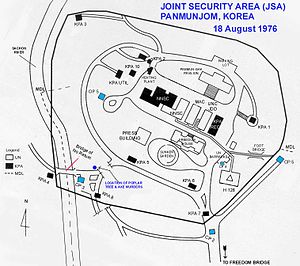- Neutral Nations Supervisory Commission
-
The Neutral Nations Supervisory Commission (NNSC) was established by the Korean Armistice Agreement signed July 27, 1953, ending the Korean War. It is, with the Military Armistice Commission (UNCMAC), part of the mechanism regulating the relations between the Democratic People's Republic of Korea (DPRK, North Korea) and the Republic of Korea (ROK, South Korea).
According to the Armistice, the NNSC shall be composed of four senior officers, two of whom shall be appointed by neutral nations nominated by the United Nations Command (UNC) and two of whom shall be appointed by neutral nations nominated jointly by the Korean People's Army (KPA) and the Chinese People's Volunteers (CPV). The term "neutral nations" was defined as those nations whose combat forces did not participate in the hostilities in Korea. The United Nations Command chose Sweden and Switzerland, while the Korean People's Army and Chinese People's Volunteers chose the People's Republic of Poland and Czechoslovakia.
On August 1, 1953, the first Swiss NNSC delegation, consisting of 96 members, arrived in Panmunjeom. The first force reduction took place in 1955, when the delegation was reduced to 41 members. In the following years, the delegation was successively reduced. Since 1982, there are six Swiss members in Panmunjom and until August 1987, exactly 700 Swiss soldiers have worked for the NNSC in Korea. The mission of the NNSC is defined in article 41 of the Armistice and reads as follows: "The mission of the NNSC shall be to carry out the function of supervision, observation, inspection, and investigation and to report the results of such supervision, observation, inspection and investigation to the Military Armistice Commission."
Contents
Overview
From June 1956 to the year of 1993, the NNSC ceased their controls but solely forwarded the war parties' reports on entering and leaving military persons to the UNCMAC. The strengths of the delegations from Poland, Czechoslovakia, Sweden and Switzerland were reduced gradually: On June 9, 1956 to 14 members each, in 1960 to nine members each, and in 1978 to six members each. Residing inside the Joint Security Area (JSA) are the offices and conference room for the NNSC. North Korea forced out the Czech component early in 1993 and the Polish component early in 1995, both shortly after those countries underwent democratization following the dissolution of the Soviet Union and the dissolution of the Eastern bloc.
The NNSC members are assisted by administrative personnel from their own countries. Camps for the Swedish and Swiss members and their staffs are located in the southern half of the Korean Demilitarized Zone (DMZ) adjacent to the JSA. The former Polish and Czech camps which were located nearby on the north Korean side of the Military Demarcation Line, have been taken over by the KPA and are now used for other purposes.
Post-2008 status
Since 2008 the main role of the NNSC is to maintain and to build relations with both sides and maintain channel of communications open between them. Five Swiss representatives and five Swedish representatives are stationed in Panmunjeom, South Korea, on duty for the NNSC. Presently, their main task is to show presence at the inner Korean border and thus demonstrate that the ceasefire is still in force. Occasionally Polish delegates attend the meetings at Panmunjom, but through South Korea, as Poland has changed sides politically. The promotion of détente and security in the Joint Security Area (JSA) also falls within the framework of these activities and are the prerequisites for the accomplishment of these tasks.[1]
External links
- Peace Support - Mission in Korea (NNSC) information about the Swiss participation to the NNSC mission in Korea.
- Feature story (in German) and photos about the Swiss NNSC mission in Korea.
- Sweden's participation in the NNSC
References
- ^ NNSC Factsheet URL retrieved July 27, 2011
Categories:- Korean Demilitarized Zone
- Commissions
- North Korea–South Korea border
- Separation barriers
- Aftermath of the Korean War
Wikimedia Foundation. 2010.


